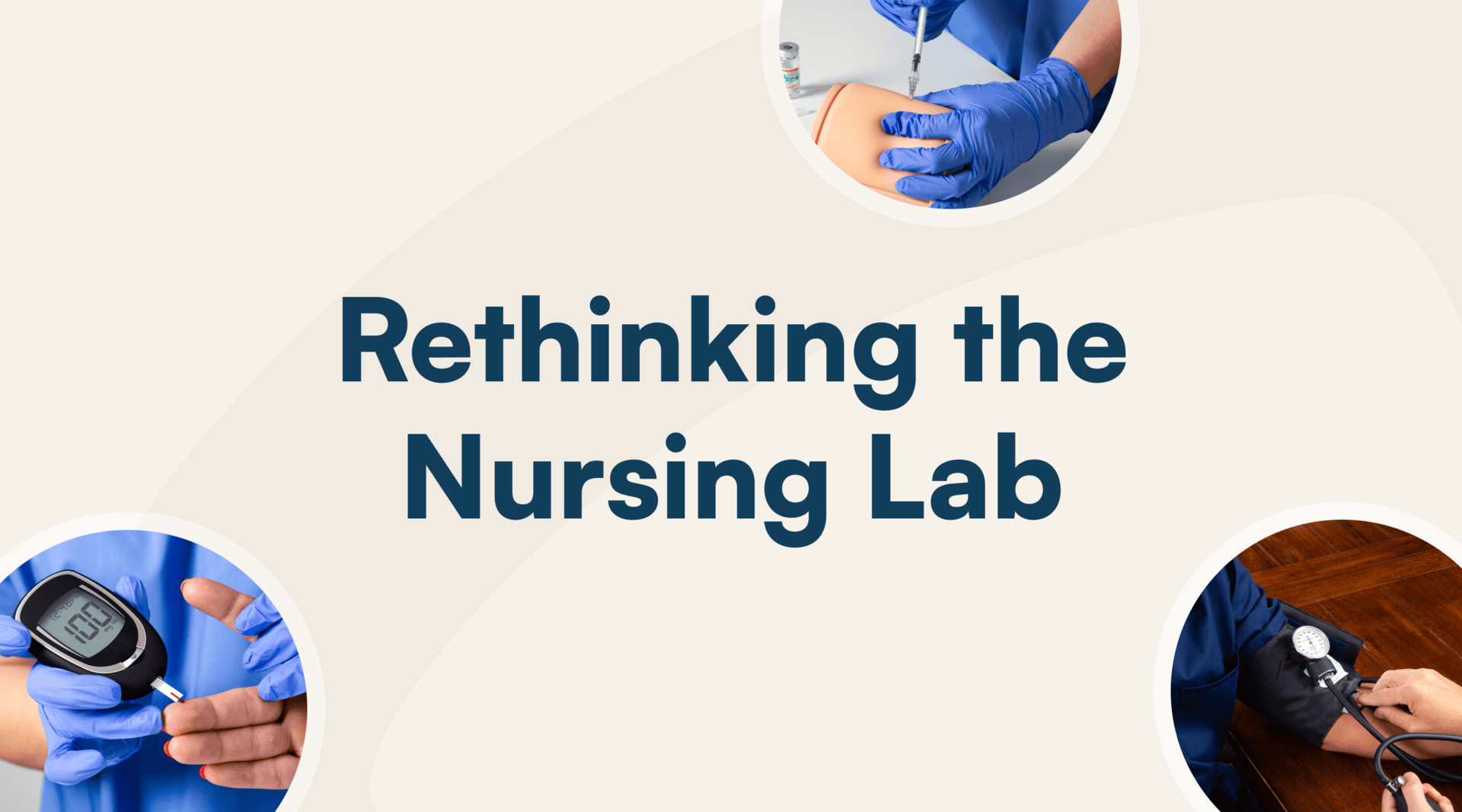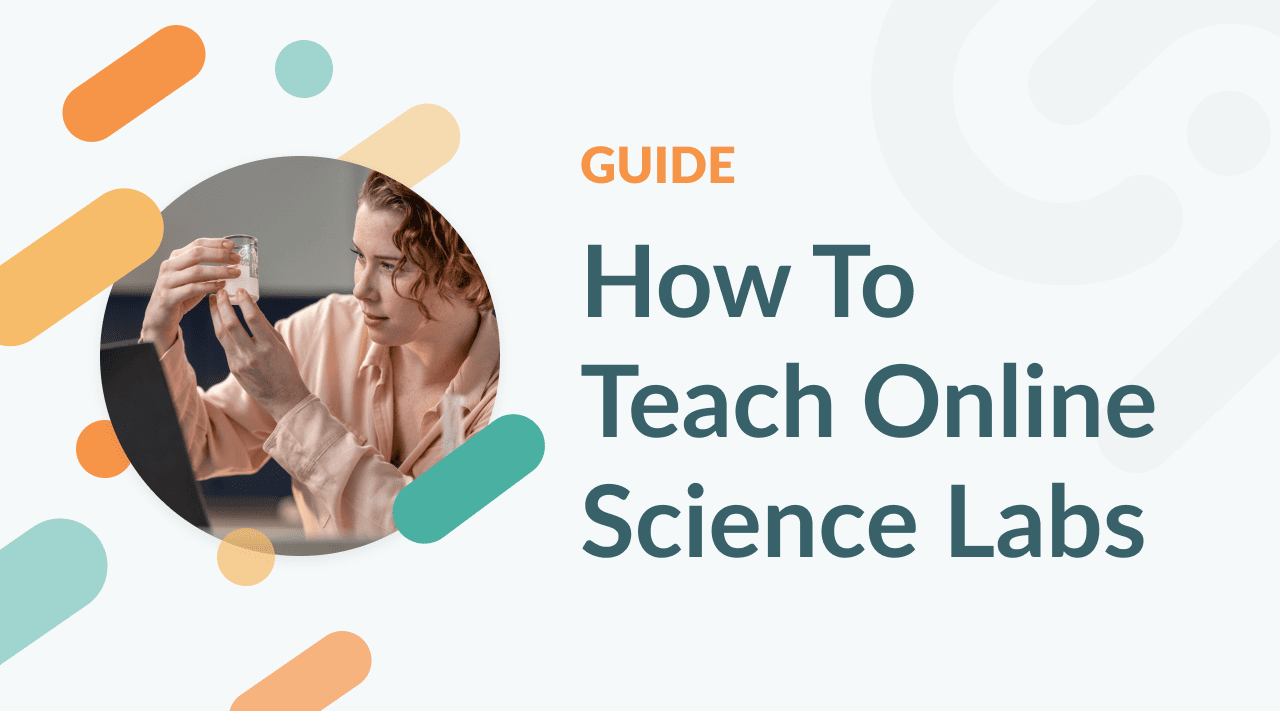Strategies, Tactics & the Right Tools for Ensuring Student Success
Summary
Most things once seemed impossible: cordless phones, cooking without direct flame (hello, microwaves!), and cars powered by battery are just a few. Now, add to the list teaching science labs online. In fact, as colleges continue shifting courses online in an effort to expand offerings, more and more students are showing interest in online STEM courses and expecting many of the same opportunities as on-campus students, including hands-on lab experiments.
If you’re new to or have just a couple years of experience teaching lab science courses online, this guide is for you. In addition to understanding the different approaches you can take with your online labs, you’ll gain insight into the online tools for teaching science effectively, strategies on where to focus your efforts, and tips you can start using today.
If you’re a seasoned online science instructor, this guide will give you a fresh take on how to approach your labs. You’ll pick up quick tips that will help you further engage students and discover new ways of delivering online labs that are just as rigorous as in-person lab experiences.
What Effective Online Science Labs Look Like
In 2022, more than three quarters of learners reported that they decide on the online modality before any other factor, and more than half would choose an entirely different institution if their course/program wasn’t online. That means, to remain competitive, your science programs need to be online, and they need to meet the expectations of today’s learners, which according to student evaluations and surveys from American University include:
| 1. Excellent guidance & expectations, which include a range of instructional materials (e.g., books, videos, web resources, collaboration tools, options to speed up the videos, transcripts, and shorter lectures), expectations for participation, and feedback for improvement. 2. Smaller courses so that access to instructor support is feasible. 3. High quality, traditional classroom–style features for a comparable experience, like virtual office hours session (i.e., live chats), other forms of communication, and in the case of science lab courses, experiential learning activities like hands-on science experiments. 4. Good video guidance and other multimedia, the learning medium of choice for college-age students, that includes orientation to the course and time management, along with weekly introductions to the topic. This helps students make connections across course material — especially important when it comes to aligning your labs with course concepts. 5. Social learning and connections across the courses, with the instructor, each other, and the content. |
But we get it…when you’re figuring out how to teach science online effectively with lab components — labs that deeply engage your students while balancing both cost and safety considerations — you face a unique set of challenges most other disciplines don’t. We can also help you get there. Use this guide and focus on these critical areas to ensure you deliver a learning experience that not only satisfies online students’ expectations but also encourages them to pursue future science courses.
✔️ Decide Your Approach: Hands-on or Virtual
✔️ Maintain Quality & Rigor
✔️ Leverage Strategies that Engage Students at Home
✔️ Ensure Safety, Accessibility & Academic Integrity

Step 1: Choosing Between Virtual Science Experiments & Hands On
When you first start planning your science labs online, one of the most important steps is determining your approach—that is, will you use virtual or hands-on science experiments? The truth is that while some labs are better suited for hands-on experimentation at home, others are not. An effective course will use an intentional blend of hands-on experimentation with digitally simulated labs. Before we get into the when and why, let’s first quickly review these two main approaches.
Virtual science labs, also known as online science lab simulations, are interactive, digital simulations of activities that would typically take place in physical laboratory settings. This is an interactive experience during which students observe and manipulate computer-generated objects, data, or phenomena in order to fulfill the learning objectives of a chemistry, physics, biology, or other laboratory experience.
Hands-on science labs provide students with physical, hands-on science experiments to expose students to the process of manipulating, observing, exploring, and thinking about science using concrete materials. Hands-on labs use tools, equipment, tests, and procedures. This approach relies on ready-made science lab kits that contain lab-grade materials and equipment at a scale so that students can safely handle them without direct supervision.
The Approach: Hands-On Science Labs
Online science labs need to include materials and equipment that allow students to generate data by performing replicable experiments, just like their campus counterparts.
In fact, according to data from the 2023 Annual Lab Report, 80% of the 1,293 students surveyed said they wanted a hands-on component, compared to only 20% who preferred virtual simulations only, in their online course. Similarly, the majority of instructors (84%) said they prefer incorporating hands-on labs into their online courses. The reason? Both instructors and students felt that students learned more, which is only further highlighted by the 85% of instructors using hands-on labs who were more confident students could apply what they learned to the real world.
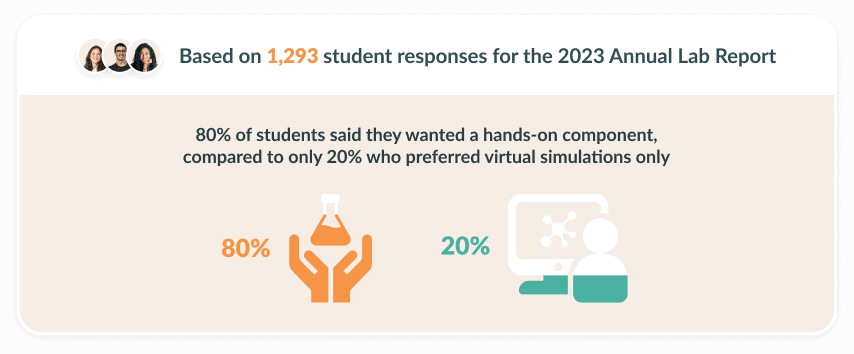
Hands-on online science labs allow students to physically conduct experiments at home or in their local environment using science lab kits that are mailed to students. These kits contain the same basic equipment found in a campus laboratory and are meant to be tailored to meet the needs of nearly any science curriculum. Instructors plan their curriculum, decide which labs they want students to perform physically, and then easily coordinate those needs with a company who provides these kits.
This approach creates complete consistency in materials for students, and you have the most flexibility in what kinds of experiments you use as a part of your lessons. You can be assured that all kits contain the highest quality materials. At the same time, vendor-sourced kits are created specifically to be used safely at home without instructor supervision. They are designed with microscale and Green Chemistry principles – and come with all the PPE equipment your students need, along with mandatory lab safety lessons that must be completed prior to unlocking their lab content — making them safer than the other sourcing options. Students can purchase their kits via their campus bookstores or direct, and have them shipped.
When to Choose the Hands-On Approach
Use hands-on science experiments when you want to deliver an authentic and more holistic learning experience online.
In addition to saving time and ensuring access to safe lab-grade materials, hands-on kits help you mirror the quality and rigor of an in-person, campus lab experience as closely as possible. Unlike virtual science labs, students gain the hands-on experience of using equipment and carrying out experiments — building technical and psychomotor skills as well as expanding students’ abilities to develop the problem-solving and critical thinking skills students would in a traditional lab. Comparative studies suggest that students learn just as much from these labs and in ways similar to those who attend in-person labs (Casanova et al., 2006; Reuter, 2009).
Still, further research out of Stephen F Austin State University focused on the effects of hands-on experiences related to student engagement and performance achievement in chemistry. These studies showed that student participation in hands-on laboratory experiences vs computer simulated experiences actually improved students’ attitudes and interest in the topic being taught, kept students more engaged, and led to new skill building and better performance. These findings stress the importance of instructional practices that physically engage students in the learning process, especially critical for math and science.
Use the hands-on approach when you want to:
✔️ Increase inclusivity by activating all the different styles of learning
✔️ Engage students in a more authentic lab experience, helping them better master course concepts
✔️ Elevate the quality of the online learning experience by helping students learn the physical & critical thinking skills necessary to run an experiment
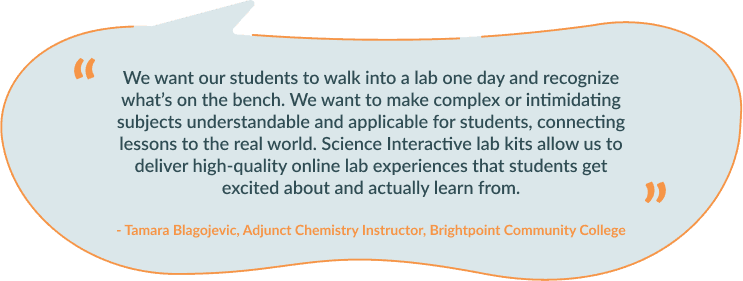
The Approach: Virtual Science Labs
Virtual science labs or simulations use a variety of technologies and tools to produce digital presentations that show students how something works. Some simulations are like videos — students simply click play and watch the simulation take place — whereas others are interactive, allowing them to manipulate variables in the simulation to discover different outcomes. Still, other simulations use a game format that allows students to work together. Some examples of simulations include representations or animations that demonstrate a law of physics, illustrate a chemical reaction, or explore the effects of gravity.
When to Use Virtual Labs
Online science lab simulations are often defaulted to in online science lab courses because they are easier to implement than hands-on science experiments. However, when used as the singular form of learning throughout a course, they are not as effective when it comes to student learning and performance. That said, consider using virtual labs when:
✔️ You want students to observe the unobservable. Virtual labs can portray abstract objects, such as light rays, that students cannot see in a physical lab. Climate change and evolution, for example, can be simulated using an online lab but would be difficult to teach physically.
✔️ You want to balance costs in your course and make it more practical. Making every lab hands-on could become very expensive, like those that require high-resolution microscopes, for example. Similarly, labs calling for large apparatuses would make shipping impractical. To balance costs and feasibility, insert virtual-scope lessons and other virtual labs throughout your course.
✔️ You want to supplement learning and allow for repeatability. Unlike the finite materials of a physical lab, it doesn’t matter, except in time, whether a student runs a digital experiment one time or 20 times to get the desired result. With each simulation, students can manipulate variables, run the experiment, and immediately see the results, especially important for struggling students. This is also a great way to introduce interesting concepts that don’t directly align with your course objectives.
In the end, the most effective courses will use an intentional blend of both virtual and hands-on science labs — and help you keep course costs reasonable and create a more effective learning environment in which students can more easily connect course concepts to the real world.


Step 2: Engaging Your Students Online
Generally speaking, the concept of student engagement is predicated on the belief that learning improves when students are inquisitive, interested, or inspired, and that learning tends to suffer when students are bored, dispassionate, or disaffected. As an instructor, you know better than anyone that keeping the students who sit right in front of you engaged in your class can be challenging. Now imagine how easy it is for a student to disengage when they no longer have an instructor in front of them. Learning online is different — a skill to be practiced and only effective when a student fully engages, which is why it’s so important to begin implementing these strategies for how to engage students in online learning.
Use Experiential Learning to Reach More Students
While every college and university defines student engagement slightly differently, and benchmarks evolve over time, one of the key factors to consider when defining what meaningful engagement looks like in your course is: Involvement & Activity.
This is where experiential learning comes into play, and while it can be difficult to facilitate when students aren’t in the room, research shows how critical it is for enhancing student learning. The idea is that for students to break out of their usual passive mode of learning, they have to DO something to activate their learning in order to gain a deeper understanding of the course content. Use of hands-on learning through science experiments can achieve that.
When you use hands-on experiments in your course, you’re able to reach ALL of your students because each type of learner can benefit from the experiential learning activity. Through the process of conducting an experiment — from setting up to logging observations and analyzing results — each student will have an opportunity to engage just a bit deeper with your course material in a way that suits them and that leads to stronger critical thinking and problem solving skills.
Set Expectations & Provide Ongoing Guidance
In addition to establishing an active learning environment for your online students, how you set the stage for your online course can set the tone of a student’s level of engagement. That’s why providing clear expectations and guidance for how and when to complete course activities is important. Because many students don’t plan well or may not know how long an experiment may take, always be sure at the start of the course and at the top of every lesson to:
✔️ Remind students how and where to find course material, and explain how that material aligns with the objectives of the course.
✔️ Keep due dates for important labs and assignments top of students’ minds and make sure a syllabus and online rubric tied to the course’s learning outcomes are highly visible.
✔️ Provide them with resources and step-by-step instructions for each experiment.
✔️ Anticipate potential questions from students and prepare a quick FAQ resource for each experiment — especially helpful for students new to taking a lab course online.
✔️ Share ongoing feedback with students so they have an opportunity to improve for the next lesson.
And just when you think you might be providing too many resources or answering too many questions, consider that each student coming into your course has a different level of requisite knowledge. For example, while some students may have used some of the materials in their hands-on kits before, others may struggle to even identify the name of those materials. Because you’re not in the physical lab to provide an orientation, use tools like online annotation to provide a resource that makes identification easier for them and serves as a refresher for others.
Finally, use online tools for teaching science, like lab management platforms, to provide ongoing feedback to each student throughout the course. With tools like this, you can leverage question banks, test your knowledge modules, and multiple choice quizzes enabled with automatic grading so grades sync directly with your LMS — all of which helps you focus your time on providing quality ongoing feedback, which is proven to motivate students to continue engaging.
Plus, with platforms like this, you have access to assessment analytics that can help you identify students who may be falling behind in certain areas — giving you the opportunity to provide the extra layer of guidance that gets them back on track.
| Case Study Spotlight: University of California San Diego Division of Extended Studies Using lab management technology, instructors customize lessons by integrating their own lectures rather than building plans from scratch, and use automatic grading to optimize their time. Students complete standardized lab reports in the system, which makes it easy for instructors to grade — and have those grades automatically passed back to Canvas. The ease of use has allowed the Division to increase the speed of adoption, providing instructors with a greater capacity to focus on what matters most — teaching. |
Leverage Multimedia for Content Delivery
Video has revolutionized the delivery of information. In fact, new research digs deeper into why students prefer YouTube to study and learn, while additional studies find that 83% of people prefer watching videos to access information or instructional content.
✔️ Consider employing a variety of multimedia, including video, to deliver content.
Use open educational resources and other forms of readily available media. Textbooks, journal articles, podcasts, simulations, case studies, video, multimedia, and interactive learning objects are just some of the ways you can deliver concepts to students. Share perspective through recorded video microlectures to synthesize key concepts in the course material and provide friendly video reminders around expectations. When you offer instructional content and resources in a variety of ways, you’re going to be able to reach a broader set of students whose abilities and learning styles all vary.
Build Community through Collaboration
When it comes to engaging students online, keep in mind the power of building community. Whether it be the lack of face-time with instructors or other students or the sense of isolation online learners may experience, online learners struggle more than those in face-to-face courses — and part of the reason is that loss of interaction.
Like many aspects of teaching, helping students develop a sense of belonging and community can impact learning in both face-to-face and online courses, but attending to these dimensions in an online science lab takes intentional planning. When students feel they belong to a class community, they are more likely to be motivated to complete class work, feel safe enough to ask questions or for more help, and be open to feedback that can help them improve.
To start enabling collaboration and community in your online labs, consider the following activities.
✔️ Create online lab partner pairs, similar to lab partners in campus labs. Pair up students at the beginning of the course, so each student has built-in peer support and someone they can go to — besides you — to ask questions and share experiences. Encourage them to communicate via course chat, text, and video.
✔️ Encourage students to collaborate by sharing their lab results for particular experiments on your course discussion boards; have them compare and contrast results and hypothesize why there might be differences.
✔️ Depending on your course discussion board, have students share videos and photos of their experiment setups and their thoughts on what they hope to get out of your course.
✔️ Break the class into small groups to have students work through certain lessons, using chat or video conferencing. This works particularly well for virtual labs where students are already using a variety of digital tools to complete the simulation.
| Case Study Spotlight: BrightPoint Community College While students perform their hands-on experiments independently from home, chemistry Professor Tamara Balgojevic sorts students into smaller groups to work through lessons together, which enables students to collaborate and learn from one another throughout the course. Experiencing labs this way better reinforces the lessons and helps students more easily apply course concepts to the real world — helping build class community and make the discipline feel more relatable and less intimidating. |

Step 3: Ensuring Safety, Accessibility & Academic Integrity
Like traditional labs, keeping a focus on student safety, accessibility for all learners, and academic integrity is crucial for facilitating effective online science labs.
How to Prioritize Student Safety
In the real world, things get messy. Accidents happen. Not everything goes as planned. What comes from those experiences is an ability to think swiftly and an opportunity to practice navigating the unexpected — skills that can’t be practiced or learned simply through a few clicks of a mouse.
At the same time, because students don’t have the same direct supervision of their instructor as they would in a campus lab, online science labs with a hands-on component must prioritize safety above all else. In addition to providing students with resources and step-by-step instructions for preparing their lab space, there are some key things you can do to maintain their safety.
✔️ Be sure your lab kits contain all the proper lab equipment and PPE for students.
✔️ Only include experiments that use small-scale or carefully controlled amounts of chemical that are safe to use at home, and that limit toxicity by offering formalin-free materials and non-virulent microbes.
✔️ Require students to complete lab safety lessons that cover all precautions for handling equipment and materials, as well as protocols for potential emergencies.
✔️ And if a lab ends up requiring too many chemicals or materials potentially too dangerous for the home, consider inserting a virtual science lab for this lesson.
In the end, since the instructor cannot be physically present when each student conducts a lab experiment, all hands-on labs should be designed purposefully to support students through each step of an experiment.
| Bonus Resources! Check out this quick read on the 4 essential student safety tips from scientist and instructor Dr. Yu. And then download our must-have checklist and best practices for ensuring student safety during hands-on labs. |
How to Reinforce Academic Integrity in Online Learning
It may not surprise you to learn that in a study from Marshall University, 33% of the 635 students surveyed admitted to cheating in an online course, and according to OnlineCollege.org, 55% of college presidents said plagiarism has increased in recent years, most likely due to students’ increased access to online resources. Let’s face it…cheating in online courses is easier than ever but with the following tips, you’ll have a higher likelihood of maintaining academic integrity in online learning — essential if you’re looking to preserve the quality of your course and really want to see students succeed.
✔️Use a lab management platform designed to uphold academic integrity.
The technology you use to power your online science labs is important for preventing academic dishonesty. Use tools that prevent students from accessing content that will help them during evaluations, and that allow you to compare students’ work against one another.
✔️ Update assessments.
If grades start showing patterns in a way that becomes suspicious — and you’ve taught the course before — it could be that your assessment is being shared from a previous class. Create different versions of assessments to reduce the chance of students copying others’ work. Also, maintain a bank of questions in your lab management platform so you can easily create new assessments for each class.
✔️ Change up the experiments.
Change the order of experiments for students in a class and between terms to keep the data real. Or promote interest and educational value by adding other variables: Have some students test one set of variables and the other students test a different set.
✔️ Create a safe space for students.
Your interactions with students will set the tone for the course. Students need detailed feedback, and your discussions and feedback engage them in the experimentation process and let them know their work is important. Set a clear timeframe in which student issues are addressed, and when they can expect feedback and grades — all of which can help decrease student anxiety and improve morale.
✔️ Require student evidence of participation.
Have students use the lab management platform to introduce themselves through pictures or video as they unpack their laboratory kits. During the investigations, have each student produce a live video feed while doing the work or take pictures of the key steps. Students should prepare detailed lab reports, describing exactly what they did. These steps will not only promote academic integrity but will also help you troubleshoot or correct any experimental mistakes.
With simulated virtual labs, students might appear to do better — meaning, they might seem to get higher grades than those doing hands-on online labs. That’s because digital labs are often based on effort, whereas with hands-on labs, if students don’t show evidence of having completed the lab, it will impact their grade. You can’t wing it in hands-on online labs, nor complete them dishonestly, and still expect to learn the material, pass the evaluation, and get a good grade.
How to Promote Accessibility
Next up, accessibility. Accessibility in online learning means that your content is designed with all learners in mind – including those with visual, auditory, physical, or learning disabilities. Both hands-on and virtual labs can create challenges when it comes to accessibility, which is why it’s so important to choose your lab formats strategically. With the right blend of hands-on science labs and virtual simulations, you can avoid many of these challenges.
For hands-on experiments, some students might have physical disabilities or religious and ethical concerns that will make the lab inaccessible — for example, labs with animal dissection.
✔️ Consider offering a virtual or digital lab alternative for students in order to keep your lessons as accessible and inclusive as possible.
Similarly, because they rely on a variety of technologies and tools, virtual labs can also present technical accessibility issues.
✔️ Before selecting a virtual lab, check that technologies are WCAG 2.1 AA compliant and that all students will be able to use the tool easily. Some questions to ask:
- Do all videos and audio have captions and transcripts?
- Will a screen reader correctly read all aspects of the program?
- Can the entire program be navigated with just a keyboard?
- Will the program work with low-quality or unreliable internet access?
- Can the lab be completed on a phone or tablet?
An important rule of thumb is to mix in virtual labs with your hands-on experiments. Virtual science labs can reinforce topics that have traditionally been difficult for some students to master; they can introduce new and interesting concepts that don’t directly align with your learning outcomes; and they can serve as additional preparation for a hands-on experiment — that is, if they are fully accessible.

Step 4: Maintaining the Rigor of an On-Campus Lab Experience
Scientists agree. There is no replacement for hands-on learning, and nowhere is this more relevant than in online science labs — which is why it’s critical to replicate the rigor and quality of traditional labs for students learning online.
✔️ For the lessons you choose to make hands-on experiments, make sure your hands-on lab kits include the same kind of lab-grade materials and equipment comparable to those found in traditional labs.
In addition to the kits, use curricula to support each experiment that is aligned to Quality Matters standards, in disciplines certified by Quality Matters. Quality Matters is the leading global organization for quality assurance in online and innovative digital teaching and learning environments. QM works to develop current, research-supported, practice-based quality standards in online education, based on instructional design principles for online and blended courses that promote student learning and engagement.
✔️ To be sure lessons are as rigorous and high-quality as on-campus labs, they should be designed by scientists, use input from active faculty, align to Quality Matters standards, and be reviewed by instructional designers for quality, accuracy, repeatability, safety, and ADA compliance.
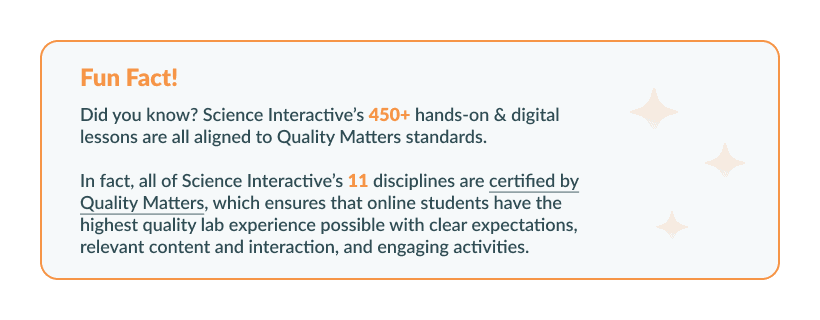
That said, you have your own teaching style, and that should come through online too just as it would in the on-campus lab. While turnkey hands-on kits and lessons are a great foundation, they shouldn’t be too prescriptive.
✔️ Customize any of your lessons by removing elements, like quiz questions, or adding tailored lab questions and supplemental materials that tie into your core learning objectives. Add text, images, and video to enhance any lesson.
Now with the right tools and flexibility to tailor lessons to your instructional style, you can shift any science lab course online, without the burden of starting from scratch, without concerns for student safety, accessibility, or quality.
Your Checklist for Teaching Lab Science Courses Online
Fully online and hybrid science courses are proving to be some of the most powerful ways to expand course offerings to additional pools of learners, including those seeking career advancement, professional development, or just starting their post-secondary studies. This presents an opportunity to create an effective online learning experience that is just as authentic as the on-campus lab experience.
To do that, combining the right mix of online science lab simulations with hands-on experiments coupled with proven engagement tactics and effective lab management technology will keep your program competitive and supercharge the effectiveness of your course. The most successful instructors will be able to adapt to the way their students learn, introduce a variety of approaches throughout their course, and as a result, deliver an effective and meaningful experience from wherever students choose to learn.
Read more to learn how Science Interactive can bring your online science labs to life.
Discover more articles
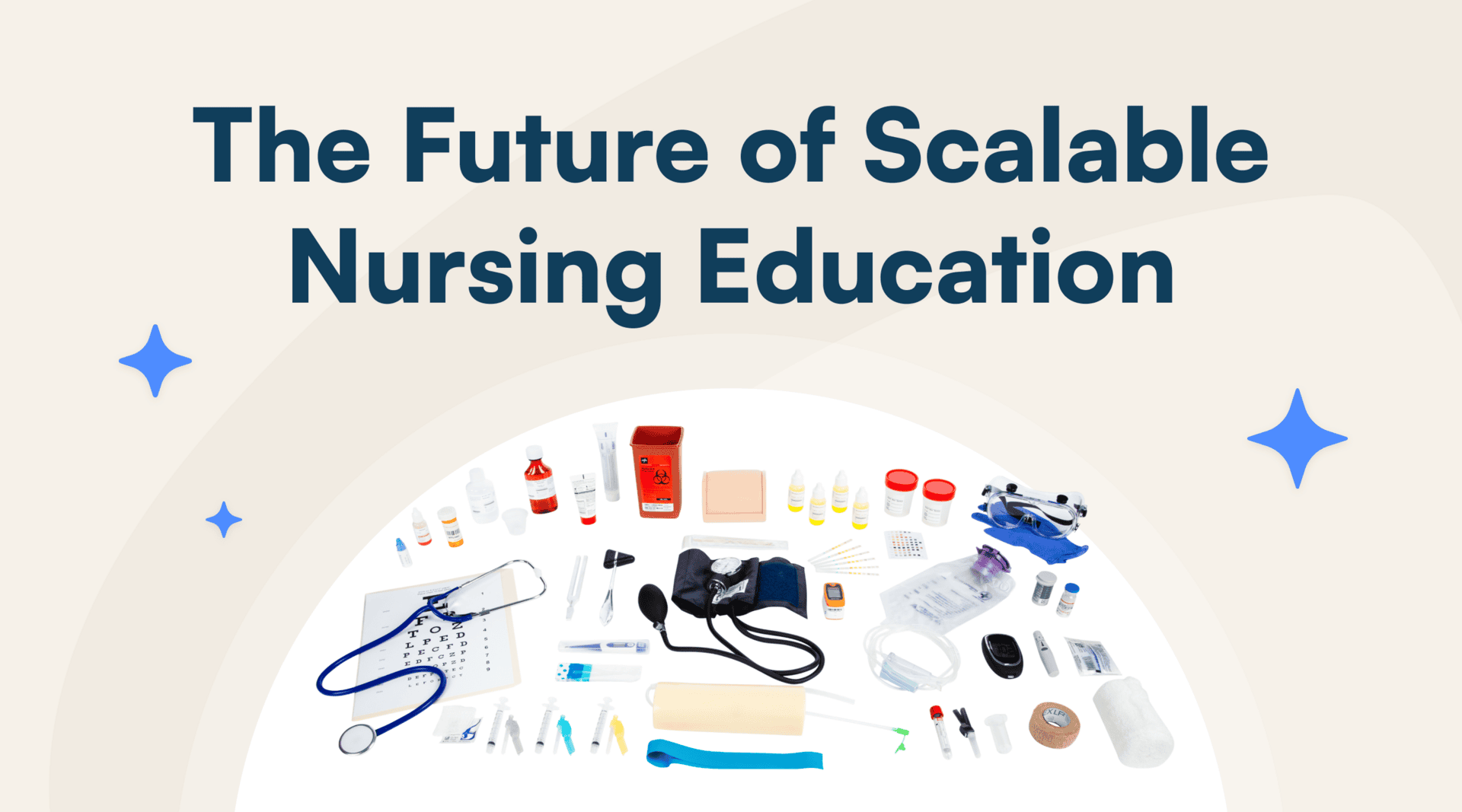
Science Interactive Launches New Nursing Fundamentals
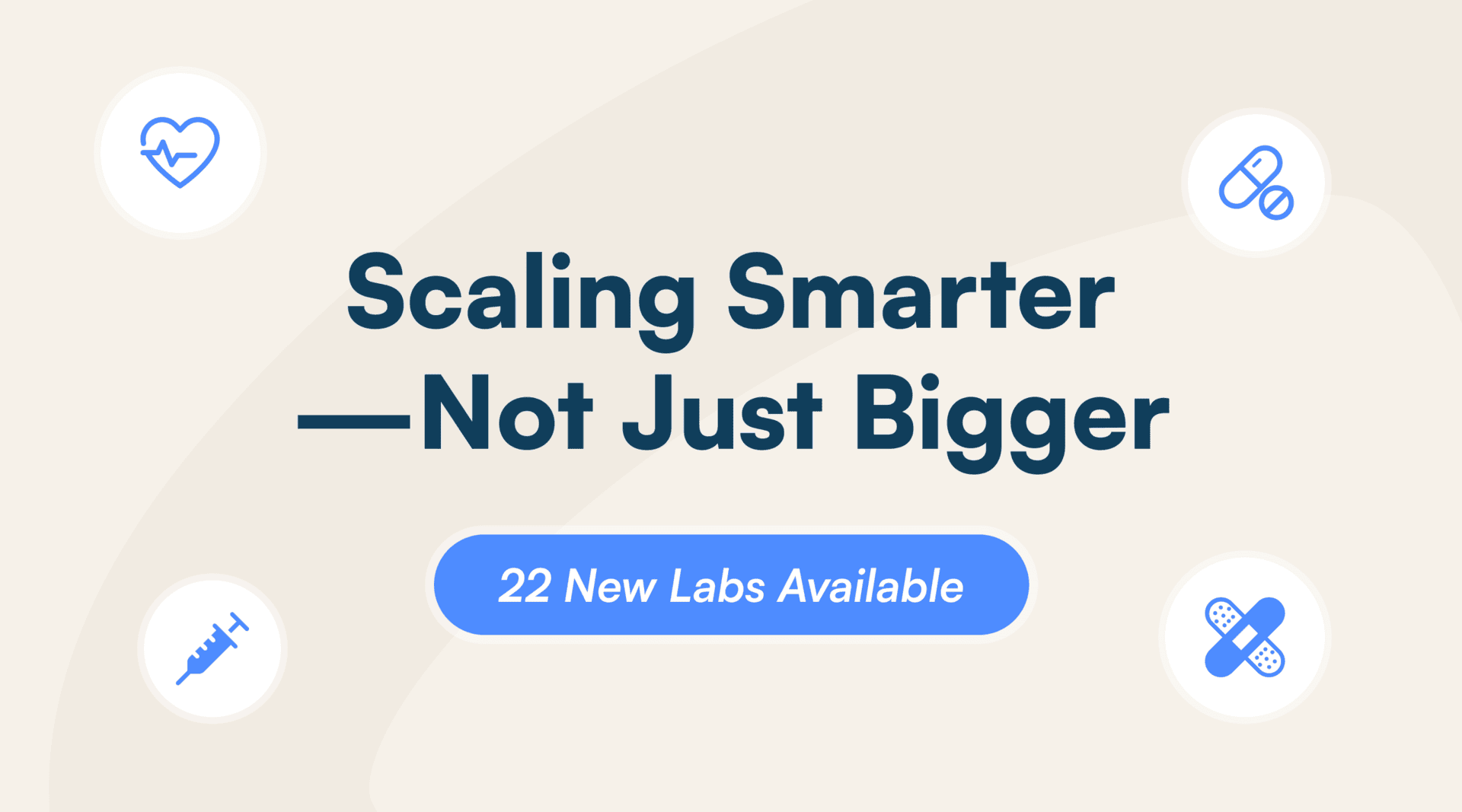
What Clinical-Ready Actually Looks Like (And How to Get There Sooner)
